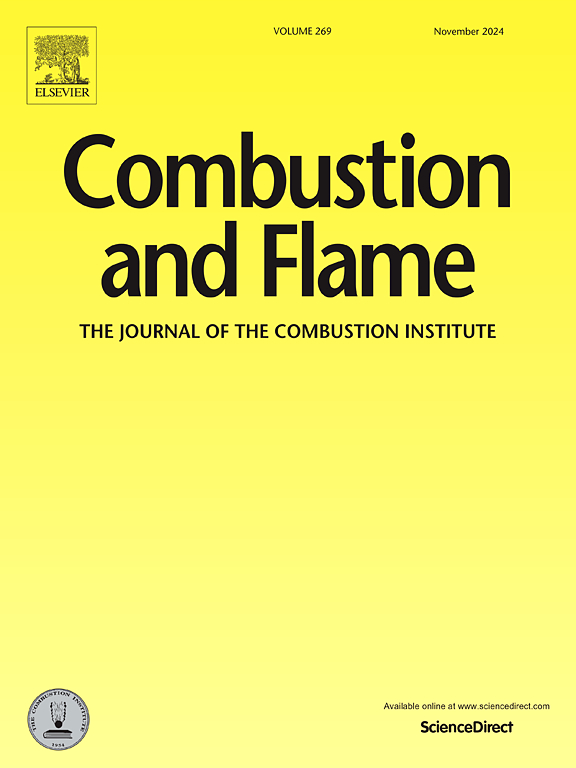Experimental study and kinetic modeling of NH3/DME blends oxidation in a jet stirred reactor
IF 5.8
2区 工程技术
Q2 ENERGY & FUELS
引用次数: 0
Abstract
Since both can be obtained from renewable sources, ammonia and dimethyl ether (DME) emerge as one of the most promising fuel combination candidates. In this study, NH3/DME oxidation experiments were conducted within a jet stirred reactor (JSR) across various operation conditions to reveal kinetics of NH3/DME co-combustion. A detailed chemical mechanism was proposed to reasonably reproduce the measurements. The experimental results underscore the significant enhancement of DME on NH3 oxidation, where a notable decline in the initial oxidation temperature of NH3 was observed as the blending ratio of DME increased. At lean and stoichiometric conditions, NO concentration maintained a high level, exhibiting a consistent upward trend as the temperature progressively rose. The low NH3/high DME blending conditions are more liable to lead to the conversion of NH3 to NO. Whereas at rich conditions, the NO formation was inhibited. Moreover, the simulation results show that our proposed model could provide accurate predictions on the concentrations of NH3, O2, CO2 and CO, but underestimate the rates of NO formation reactions. Overall, the present model has better prediction performances on NH3/DME oxidation compared with the existing mechanism in the literatures. According to the sensitivity analysis, it is found that CH3OCH3(+M)=CH3+CH3O(+M) and H+O2=O+OH are the major reactions that trigger production of OH and HO2 active radicals, which promote the NH3 oxidation reaction and the formation of NO further. While the chain termination reactions NH2+NO=N2+H2O and CH3+HO2=CH4+O2 inhibit the reactivity. The HNO pathway dominates the formation of NO. With the escalation in the blending ratio of DME, the HNO pathway is strengthened, thereby causing a higher NO conversion. Above all, this research offers valuable insights into the oxidation mechanisms of NH3/DME and provides reliable empirical data sources for model construction and optimization.
射流搅拌反应器中氨/二甲醚共混氧化的实验研究及动力学建模
由于两者都可以从可再生能源中获得,氨和二甲醚(DME)成为最有前途的燃料组合候选之一。本研究在喷气搅拌反应器(JSR)中进行了不同操作条件下NH3/二甲醚氧化实验,以揭示NH3/二甲醚共燃烧动力学。提出了一个详细的化学机理,以合理地再现测量结果。实验结果表明二甲醚对NH3氧化有显著的促进作用,随着二甲醚掺量的增加,NH3的初始氧化温度显著降低。在稀薄和化学计量条件下,随着温度的升高,NO浓度保持较高水平,并呈持续上升趋势。低NH3/高DME的共混条件更容易导致NH3转化为NO。而在富氧条件下,NO的生成受到抑制。此外,模拟结果表明,我们提出的模型可以准确预测NH3、O2、CO2和CO的浓度,但低估了NO生成反应的速率。总体而言,与现有文献相比,本模型对NH3/二甲醚氧化机理的预测性能更好。通过敏感性分析发现,CH3OCH3(+M)=CH3+ ch30 (+M)和H+O2=O+OH是触发OH和HO2活性自由基产生的主要反应,进而促进NH3氧化反应和NO的形成。而终止链反应NH2+NO=N2+H2O和CH3+HO2=CH4+O2则抑制了反应活性。HNO途径主导NO的形成。随着二甲醚掺入比例的增加,HNO途径被加强,从而导致更高的NO转化率。综上所述,本研究对NH3/二甲醚的氧化机理提供了有价值的见解,为模型构建和优化提供了可靠的经验数据来源。
本文章由计算机程序翻译,如有差异,请以英文原文为准。
求助全文
约1分钟内获得全文
求助全文
来源期刊

Combustion and Flame
工程技术-工程:化工
CiteScore
9.50
自引率
20.50%
发文量
631
审稿时长
3.8 months
期刊介绍:
The mission of the journal is to publish high quality work from experimental, theoretical, and computational investigations on the fundamentals of combustion phenomena and closely allied matters. While submissions in all pertinent areas are welcomed, past and recent focus of the journal has been on:
Development and validation of reaction kinetics, reduction of reaction mechanisms and modeling of combustion systems, including:
Conventional, alternative and surrogate fuels;
Pollutants;
Particulate and aerosol formation and abatement;
Heterogeneous processes.
Experimental, theoretical, and computational studies of laminar and turbulent combustion phenomena, including:
Premixed and non-premixed flames;
Ignition and extinction phenomena;
Flame propagation;
Flame structure;
Instabilities and swirl;
Flame spread;
Multi-phase reactants.
Advances in diagnostic and computational methods in combustion, including:
Measurement and simulation of scalar and vector properties;
Novel techniques;
State-of-the art applications.
Fundamental investigations of combustion technologies and systems, including:
Internal combustion engines;
Gas turbines;
Small- and large-scale stationary combustion and power generation;
Catalytic combustion;
Combustion synthesis;
Combustion under extreme conditions;
New concepts.
 求助内容:
求助内容: 应助结果提醒方式:
应助结果提醒方式:


